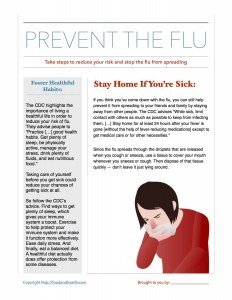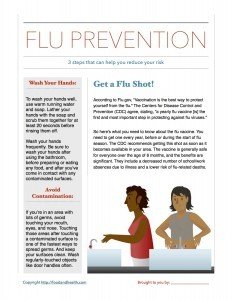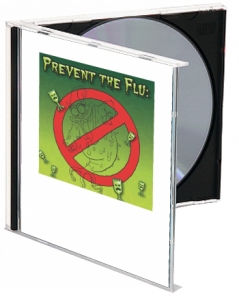3 Flu Prevention Tips
September is the month for the Cold and Flu Campaign. How are you helping your clients prepare for the upcoming flu season?Today I'd like to share 3 strategies to help your clients reduce their risk of flu. Are you ready? Here we go! Flu Prevention Tip #1: Get a Flu ShotAccording to Flu.gov, "Vaccination is the best way to protect yourself from the flu." The Centers for Disease Control and Prevention (CDC) agree, stating, "a yearly flu vaccine [is] the first and most important step in protecting against flu viruses."So here's what you need to know about the flu vaccine.You need to get one every year, before or during the start of any flu season. Although the vaccine does not protect against every single flu that could be out there, it's set up to prevent the strains of flu that research indicates will be the most common. The CDC recommends getting this shot as soon as it becomes available in your area. "It takes about two weeks after vaccination for antibodies to develop in the body and provide protection against influenza virus infection. In the meantime, you are still at risk for getting the flu. That’s why it’s better to get vaccinated early in the fall, before the flu season really gets under way" (source).The vaccine is generally safe for everyone over the age of 6 months, and the benefits are significant. Perhaps the CDC lays it out best, asserting, "Flu vaccination can reduce flu illnesses, doctors’ visits, and missed work and school due to flu, as well as prevent flu-related hospitalizations and deaths."You can get vaccinated at most doctor's offices and pharmacies, and most insurance plans cover the cost.Talk with your healthcare provider about the flu vaccine today, and remember "Flu vaccination can keep you from getting sick from flu. Protecting yourself from flu also protects the people around you who are more vulnerable to serious flu illness" (source).
Flu Prevention Tip #1: Get a Flu ShotAccording to Flu.gov, "Vaccination is the best way to protect yourself from the flu." The Centers for Disease Control and Prevention (CDC) agree, stating, "a yearly flu vaccine [is] the first and most important step in protecting against flu viruses."So here's what you need to know about the flu vaccine.You need to get one every year, before or during the start of any flu season. Although the vaccine does not protect against every single flu that could be out there, it's set up to prevent the strains of flu that research indicates will be the most common. The CDC recommends getting this shot as soon as it becomes available in your area. "It takes about two weeks after vaccination for antibodies to develop in the body and provide protection against influenza virus infection. In the meantime, you are still at risk for getting the flu. That’s why it’s better to get vaccinated early in the fall, before the flu season really gets under way" (source).The vaccine is generally safe for everyone over the age of 6 months, and the benefits are significant. Perhaps the CDC lays it out best, asserting, "Flu vaccination can reduce flu illnesses, doctors’ visits, and missed work and school due to flu, as well as prevent flu-related hospitalizations and deaths."You can get vaccinated at most doctor's offices and pharmacies, and most insurance plans cover the cost.Talk with your healthcare provider about the flu vaccine today, and remember "Flu vaccination can keep you from getting sick from flu. Protecting yourself from flu also protects the people around you who are more vulnerable to serious flu illness" (source). Flu Prevention Tip #2: Wash Your HandsWhen it comes to everyday steps that can reduce your risk of flu, washing your hands tops the charts.To wash your hands well, use warm running water and soap. Lather your hands with the soap and scrub them together for at least 20 seconds before rinsing them off. If you're in a public restroom, dry your hands with a paper towel and then use that towel to turn off the running water. This will help prevent re-contamination.Wash your hands frequently. Be sure to wash your hands after using the bathroom, before preparing or eating any food, and after you've come in contact with any contaminated surfaces.If you don’t have access to running water, use an alcohol-based hand sanitizer that contains at least 60% alcohol. Hand sanitizers eliminate many germs, but they are not as effective as soap and water.
Flu Prevention Tip #2: Wash Your HandsWhen it comes to everyday steps that can reduce your risk of flu, washing your hands tops the charts.To wash your hands well, use warm running water and soap. Lather your hands with the soap and scrub them together for at least 20 seconds before rinsing them off. If you're in a public restroom, dry your hands with a paper towel and then use that towel to turn off the running water. This will help prevent re-contamination.Wash your hands frequently. Be sure to wash your hands after using the bathroom, before preparing or eating any food, and after you've come in contact with any contaminated surfaces.If you don’t have access to running water, use an alcohol-based hand sanitizer that contains at least 60% alcohol. Hand sanitizers eliminate many germs, but they are not as effective as soap and water. Flu Prevention Tip #3: Avoid ContaminationTo avoid contamination, stay away from sick people.If you’re in an area with lots of germs, be sure to avoid touching your mouth, eyes, and nose. Touching those areas after touching a contaminated surface is one of the fastest ways to spread germs.Influenza can live on a surface for 2-8 hours after first contact, so don’t take any chances! Keep your surfaces clean and wash regularly-touched objects like door handles often.There are lots of other things that your clients can do to reduce their risk of the flu. If you're a member, don't miss the new handout and post, 2 More Flu Prevention Tips, where you'll find... well... exactly what you think!
Flu Prevention Tip #3: Avoid ContaminationTo avoid contamination, stay away from sick people.If you’re in an area with lots of germs, be sure to avoid touching your mouth, eyes, and nose. Touching those areas after touching a contaminated surface is one of the fastest ways to spread germs.Influenza can live on a surface for 2-8 hours after first contact, so don’t take any chances! Keep your surfaces clean and wash regularly-touched objects like door handles often.There are lots of other things that your clients can do to reduce their risk of the flu. If you're a member, don't miss the new handout and post, 2 More Flu Prevention Tips, where you'll find... well... exactly what you think! And, because I love ya, I've whipped up a new handout that covers the top tips from this post as well. What will you do with your copy?
And, because I love ya, I've whipped up a new handout that covers the top tips from this post as well. What will you do with your copy? Want to offer your clients even more resources! Here's a peek at a few of the amazing flu prevention materials available in the Nutrition Education Store. Remember, we're here to help you look your very best, right now...
Want to offer your clients even more resources! Here's a peek at a few of the amazing flu prevention materials available in the Nutrition Education Store. Remember, we're here to help you look your very best, right now... 

